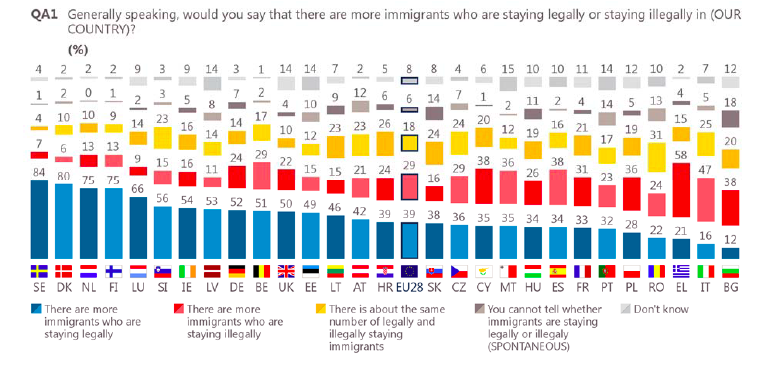
Read more
Blog, Public Attitudes
The Special Eurobarometer on Integration of immigrants in the European Union: How do Italians differ in their views compared to the rest of Europe?
As the recent elections in March 2018 confirmed, immigration is a highly salient issue in contemporary Italy. The latest publication of the Special Eurobarometer survey on the integration of immigrants in the European Union...
Last week the Eurobarometer published the aggregated data of their special survey on the integration of immigrants in the European Union (Special Eurobarometer 469). Although the most informative findings will only come after the upcoming publication of the study’s individual-level data, for those working on attitudes to immigration (such as us at the Observatory of Public Attitudes to Migration) the release of such high quality, pan-European data is still of some interest. In this blog I briefly run through some of the more noteworthy findings and discuss how they relate to what we already know about attitudes to immigration.
- 1. Europeans are more likely to believe that ‘there are more immigrants who are staying legally in my country’ than to believe ‘there are more staying illegally’ or it’s about the same. Only 6% give the response that ‘you cannot tell’. Judging from the high variation by country, it seems that more ‘pro-immigration’ electorates are more likely to believe the (almost certainly true) possibility there are more legal than illegal immigrants, though of course, the veracity of the proposition could vary by country anyway. As the Eurobarometer report points out, ‘countries with a high level of respondents who say that there are more immigrants staying illegally are either along the Mediterranean coast or at the Eastern border of the EU.’
- 2. The Eurobarometer shows that Europeans tend to overestimate the proportion of immigrants in their county, though the most common response is actually ‘don’t know’. Such an overestimation is commonly found and not only regarding estimations of immigrant numbers but also regarding many other political issues such as overestimations of inequality and other estimations that are both disputable and highly polticised.
- 3. One of the more interesting findings is the level of interaction with immigrants by Europeans—61% claim to do so at least once a week. Some scholars argue that intimate (or ‘close’) contact with immigrants (i.e. friendship, co-workers relationships) is likely to increase positivity to immigration, whereas non-intimate contact (e.g. seeing in the street) is more likely to evoke a feeling of group threat and lead to greater negativity towards immigration. However, given that attitudes tend to be fairly stable and formed early in life, the long-term effects of high contact are likely to see younger generations having more pro-immigration attitudes as their key socialisation phase happens in the context of greater immigrant numbers and ethnic heterogeneity moreover.
- 4. On the issue of estimation and contact, two interesting outliers are Greece and Italy, both of which are more likely to see immigration as primarily an illegal phenomenon and both of which have report high levels of contact. See below:


- 5. On more long-term attitudes, such as comfortability with certain social relations (friends, co-workers, neighbours, doctor) with immigrants and perceived effects of immigration, the countries break down on pretty predictable lines (Nordics and Iberians very pro, the rest of western Europe a bit less, central, east and Italy and Greece towards bottom).
- 6. The same is by and large true of attitudes to whether the integration of immigrants is a success. This reminds me of a recent talk I went to in Budapest, organised by the Friedrich-Ebert-Stiftung, in which a report by Vera Messing and Bence Ságvári argued that national-level attitudes to immigration are a function of the strength of the state, with those in weak states sceptical of the capacity of the state to handle immigration effectively. This seems fairly theoretically compelling, particularly given the somewhat intuitively anomalous case of the two Iberian countries, which, despite often characterised as relatively weak states, may have increased their citizens’ confidence in the state’s capacity following the Cayucos crisis, after which the salience of immigration decreased rapidly in Spain and attitudes remained positive.
- 7. Europeans overwhelming support government initiatives to integrate immigrants, seeing such spending as a ‘necessary investment in the long-run’.
Again, analysis of the individual-level data, once released, will give us greater opportunity for robust hypothesis testing when it comes to explaining variation in attitudes to immigration. However, it’s still useful to look through aggregate level patterns, particularly given the breadth, regularity and quality of the Eurobarometer’s data. OPAM will continue to rely on this and other data sources (particularly as a result of our collaboration with Ipsos) as we attempt to explain variation and trends in attitudes to migration across Europe and beyond.
The EUI, RSCAS and MPC are not responsible for the opinion expressed by the author(s). Furthermore, the views expressed in this publication cannot in any circumstances be regarded as the official position of the European Union.

